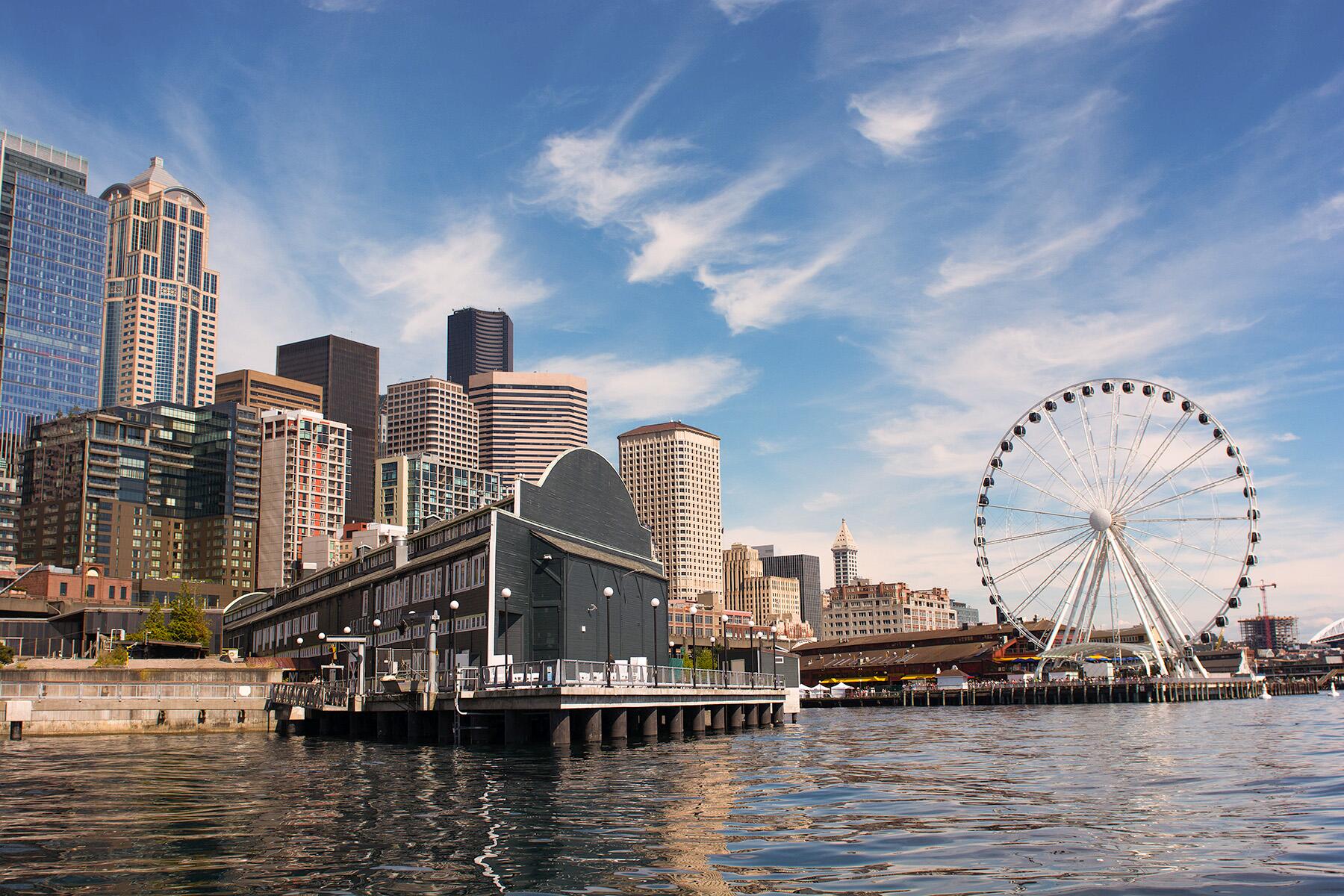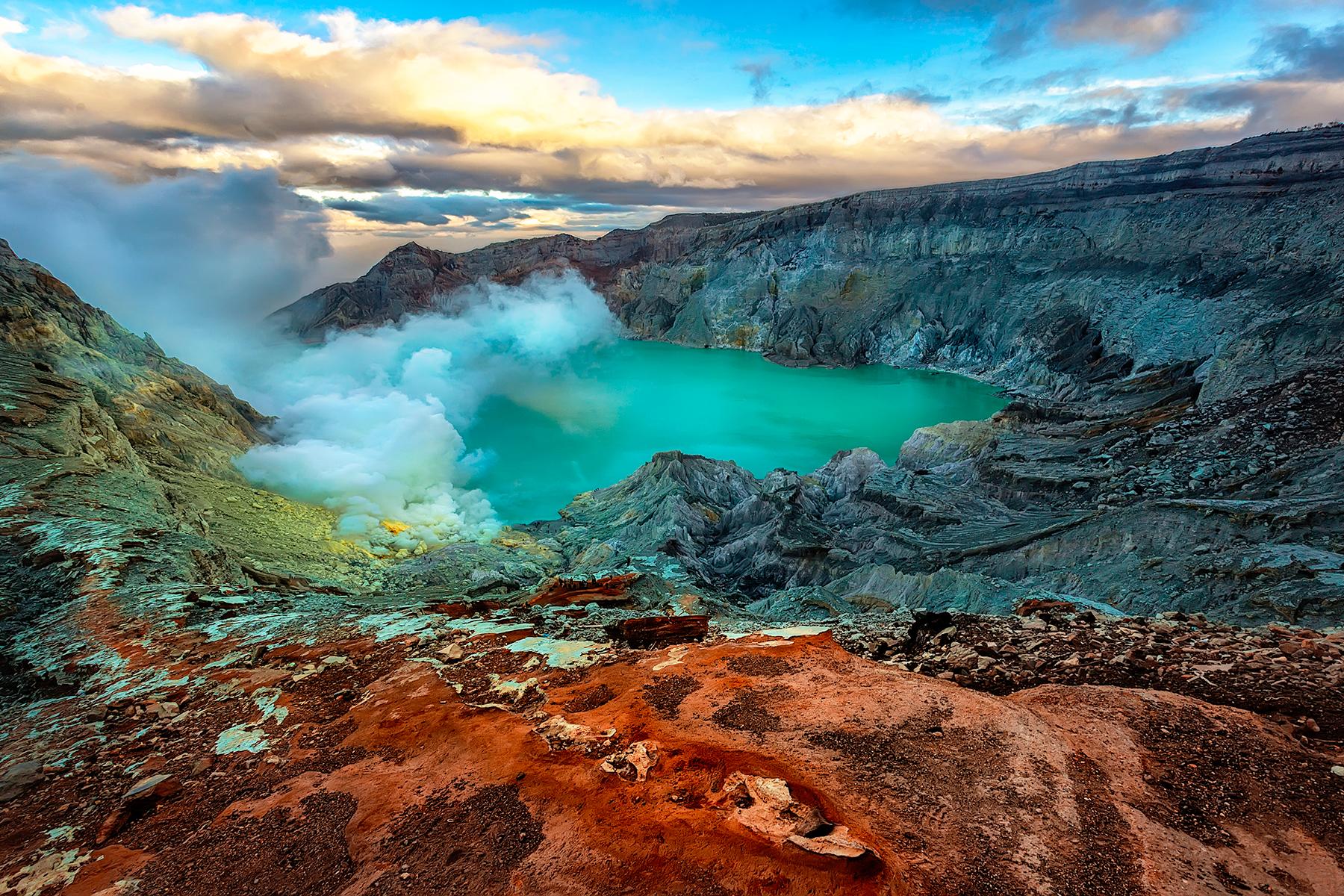Get off the beaten track in East Java and witness this rare phenomenon.
Adventurers who hike down into the steaming Ijen Crater—known as Kawah Ijen—in East Java at night will be rewarded with one of the rarest, and most spectacular, natural light shows on Earth—the mystical “Blue Fire.” But what is it and how can you see it? We’ve put together some top tips below.
INSIDER TIPKeep tabs on the wind direction and steer clear of the billowing clouds of sulfur—it’s not pleasant!
Where Is Kawah Ijen?
The vast, otherworldly Ijen Plateau is located in eastern Java and is dominated by three cones: Ijen (2,368 meters), Merapi (2,800 meters), and Raung (3,332 meters). The main attraction is undoubtedly the Ijen Crater where visitors come to marvel at the iconic, dancing blue flames, as well as the largest acidic lake in the world.
What Makes the Fire Blue?
When the darkness falls, the Ijen Crater comes alive with electric-blue flames that appear to be cascading across the rocks like molten lava. This phenomenon is actually caused by the combustion of sulfur, of which Ijen has some of the highest levels of in the world. The sulfuric gases are released from cracks in the rock at high pressure and at temperatures sometimes in excess of 1,112° Fahrenheit, which then reacts with the air, igniting into soaring flames of up to 16 feet high. Some of the gases condense into liquid sulfur, which then causes the “lava flowing” effect.
Recommended Fodor’s Video
How Do I Get There?
There are two gateways to Ijen Crater: Banyuwangi (from the east) and Bondowoso (from the west). Banyuwangi is the recommended starting point, and easily the most popular, thanks to its better roads and closer proximity. To get here, you can fly to Blimbingsari Airport—which has connections to Jakarta and Surabaya—or hop on a train or bus to the center of town. If you’re coming from Bali, make your way to Gilimanuk, the westernmost tip of Bali, and take the ferry to Ketapang Harbour in Banyuwangi. The ferry runs 24 hours and takes around half an hour. From Banyuwangi, the starting point of the hike is around an hour and a half’s drive away (prepare for a bumpy ride!).
Do I Need to Join a Tour?
This all depends on whether you want to go at it alone or have everything organized in advance, including a place to stay and transport to Ijen. It is easy enough to make your way to Ijen Crater solo with a bit of planning (and bargaining), but it is recommended to organize yourself a local guide to accompany you into the crater. Considering you will be up in the dead of night and hiking down in the dark into a steaming sulfur mine, this is the best—and safest—idea.
What Is the Hike Like?
Prepare for an early start: most hikers are up and out the door at 12 am, before making their way to the starting point of the hike at the PHKA Post at Pos Paltuding by road, where you’ll sign in and pay your entry fee (100,000 rupiahs on weekdays for foreigners/150,000 on weekends). Here you can stock up on any last-minute supplies before ascending up the signposted trail—taking around an hour and a half to reach the crater lip. Before beginning the descent into the crater, make sure your gas mask is on (your stinging eyes will thank you for it) and keep your wits about you—the half-hour descent is pretty hairy and can be slippery in places. Then grab a good spot and witness the magic of the mesmerizing blue flames. After further exploration of the lake and a pretty spectacular sunrise, the hike back takes around one hour. Most arrive back at 7 am.
What Else Can I See?
Once you’ve witnessed the blue flames, and as the darkness begins to recede, make your way to the eerily beautiful Kawah Ijen lake—the world’s largest highly acidic lake. Don’t be fooled by the inviting turquoise color, the water has a measured pH as low as 0.3 (to put this into context, battery acid has a pH of 1!). Then, you can make your way up to the highest point to witness the sunrise—the views above the clouds are out of this world. You’ll be able to enjoy the vistas on your return journey and, this time, appreciate the beautiful, forested slopes of Kawah Ijen in the daylight.
Is Kawah Ijen a Working Sulfur Mine?
Kawah Ijen has been a working sulfur mine since 1968 and you will come across a number of hardworking miners hauling heaving reed baskets of sulfur—weighing up to a mind-boggling 200 pounds—up and down the volcano on your hike. In what has to be one of the toughest jobs in the world, many miners choose this line of work over farming in local areas thanks to its higher wage: roughly $10 a day (around 800 rupiahs per kilogram, based on two trips).
What Are the Working Conditions Like?
Up to 300 miners make several daily climbs up the two miles of steep trail and down into the crater. Here they mine sulfur using a series of pipes installed under one of the volcano’s active vents. Gas inside the pipes condenses into molten sulfur, which then cools and hardens, allowing miners to break it up using metal poles. Once they load up their baskets, they make the arduous return journey with their haul. Not only is this back-breaking work, but to say the working conditions are tough is an understatement—miners are exposed to stifling heat and sulfur gas (most miners use a cotton scarf as a makeshift gas mask).
Do You Come Across the Miners?
You’ll be sharing a path with the miners, so make sure to always give them right of way, respect their space and ask permission before taking photos. To make a little extra cash, miners sell handmade sulfur souvenirs, as well as offer tourists a trolley service for hikers who are struggling. Many have become tour guides, as increasing numbers of tourists arrive every year to explore the volcano. While tourism brings in opportunities for many of the miners, it remains somewhat of a controversial visitor “attraction” in Indonesia.
What Do I Need to Wear?
You’ll be setting off on the trek around 1:30 am, when temperatures can drop to low single figures, so a warm jacket, gloves, and a wooly hat are advisable. It’s best to wear layers that you can strip of as you go, as once your heart is thumping from the steep incline of the trail, you won’t be feeling as cold. Also make sure to wear closed shoes with good grip, as the track is dusty and uneven, especially as you descend into the crater.
Any Other Essentials I Need to Bring?
A headtorch is essential as you’ll be hiking in darkness, and make sure to bring water and some snacks with you—there won’t be any kiosks on your way. If you’re taking a good camera, keep in mind that you’ll be photographing in amongst sulfur gas, so use it sparingly and keep the lens protected with a filter. If you’re on a tour, you’ll usually be given a gas mask, but you can rent one for around 40,000 rupiahs in the parking lot at the start of the trek if not.
What’s the Best Time of Year to Go?
The ideal time to undertake the hike is in the dry season between April and October, when the ground is dry and the skies are clear. However, the park is open all year round so as long as you have decent weather and clear skies, you can hike in the rainy season.
Is It Crowded?
Hiking to Ijen’s Crater is increasingly becoming more and more popular with visitors every year. According to the Jakarta Post, on average, 1,000 tourists climb Ijen Crater every day, with the number increasing to 2,000 during the weekend. Although you’re likely to be sharing the views of the Blue Fire with many others, once the sun rises, there’s much more opportunity to wander further afield to escape the crowds and find a patch of Ijen to yourself.
What Else Can I See on My Trip to East Java?
If you have two or more days to play with, make sure to also visit the equally-otherworldly Mount Bromo (jeep tours often combine the two). The main event has to be viewing the volcano at sunrise—make your way in the early hours to Penanjakan viewpoint and watch arguably one of the most dramatically beautiful panoramas in Indonesia unveil below you in a glorious golden glow—with the jewel in the crown being Mount Bromo, part of a huge crater and protected reserve called the “Sea of Sand.”




